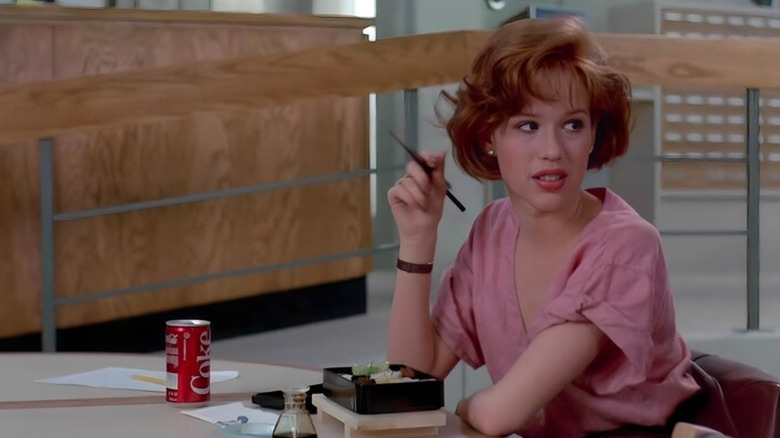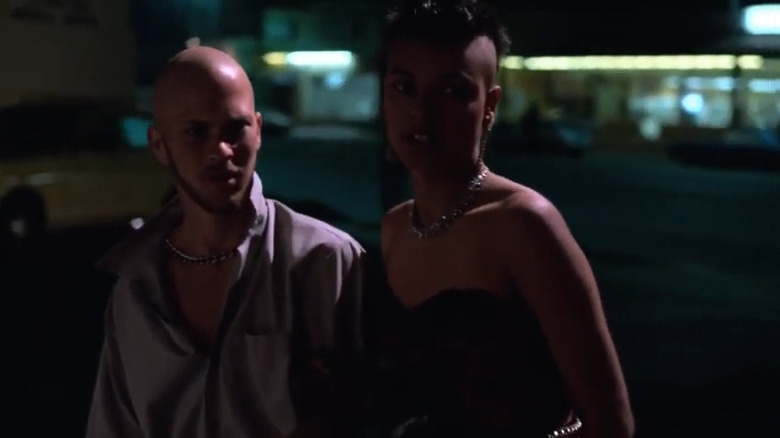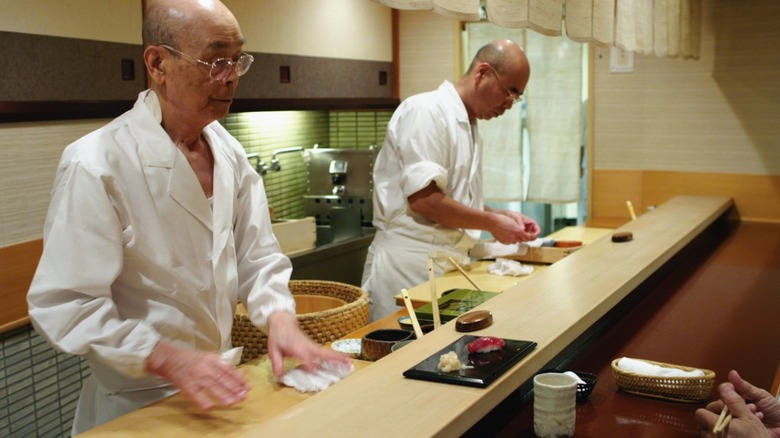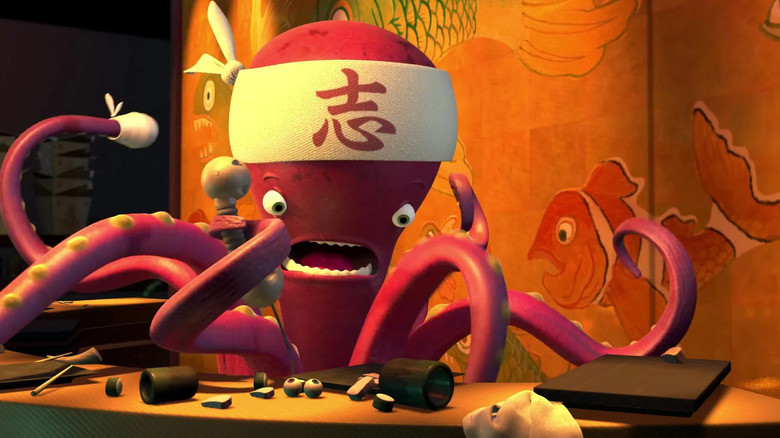No, Movie Theater Sushi Won't Save The Theatrical Experience
Thanks to the recent success of a few Spider-Man Multiverse movies, one might be tempted to say that theaters are back, baby. The worldwide theater closures brought on by COVID-19 hobbled the cinema experience in most major cities, and several theater chains experienced major closures and bankruptcies. Many notable theaters shut down, including the famous Cinerama Dome in Hollywood, California, which remains shuttered to this day. One might recall that theaters, trying to be simultaneously cautious and eager to reopen, filled their houses to quarter-capacity for a spell. Despite all efforts, box office receipts had to remain low. According to Box Office Mojo, 2019's total domestic box office was north of $11 billion. That year saw "Avengers: Endgame," "The Lion King," "Toy Story 4," and "Frozen II." 2020's total B.O. was only $2.1 billion, with the January release "Bad Boys for Life" remaining the year's highest earner.
Theaters have since reopened and are slowly gaining traction again. 2021 saw a mere $4.4 billion, while 2022 saw $7.3 billion. Not great numbers, but perhaps denoting an upward trend. We're not yet halfway through 2023, and total grosses are hovering around $3.6 billion as of this writing. A few more major hits, and perhaps the upward trend will continue.
But even in the glory days of 2019, things started to look mighty distressing. Theaters were already closing slowly across the country, and there was a general feeling that streaming services were cutting into theatrical dollars. Theaters have responded in various ways, trying to separate the theatrical experience from the home theater experience. Larger screens and better sound were one solution; IMAX cannot be replicated at home. A recent report in the New York Times declared that fancier food like sushi and heated seats are also being made available.
It. Won't. Work.
Let's get sushi and not pay
I'm old enough to remember the glory days of the 1980s and 1990s multiplex boom, as well as when people simply went to theaters more often than they do today. Movies that came in 20th at the yearly box office in 1995 would be considered major hits today, specifically: Wolfgang Petersen's 1995 film "Outbreak" which made $67 million in 1995. That's about $133 million in 2023 dollars. "Crimson Tide" made about $181 million, adjusted, which more or less matches this year's "John Wick: Chapter 4." Even the notorious bomb "Congo" made about $161 million, adjusted. That's more than this year's "Creed III." 1995 and 2019 were about equal for ticket sales, and 1995 didn't have an "Avengers: Endgame" to lean on.
All this is to say that, despite growing box office numbers, theater audiences have been generally declining for years. In 2018, the Hollywood Reporter was already covering the changing film landscape. Back in 2017, USA Today wrote about the distressing downward trends. A handy chart on the website the Numbers shows the COVID-19 dip, but also that ticket sales have been generally declining since 2004.
Theaters are desperate to get you back. They want to sweeten the pot in any way they can. There are theaters that offer D-Box experiences, which is the modern-day update of William Castle's Percepto gimmick from his 1960 film "The Tingler." The now-defunct Tiffany-like Arclight Cinemas tried to make the theatrical experience more exclusive, offering larger seats you could choose ahead of time. It's not a new idea, but some theaters are offering pull meals with the movies, providing audiences with an attentive wait staff and sushi on the menu.
Some may see the efforts as, well, a little pathetic.
We don't want sushi
First of all, offering high-end foods and a full menu during a movie is hardly a new idea. The Alamo Drafthouse has been offering that service for decades, serving beer and outfitting its theater seats with proper tables for filmgoers to eat whole meals while they watch. Additionally, many widespread, mainstream movie houses long since moved past the mere "popcorn and soda" menu to provide other carnival foods like soft pretzels, pizzas, chicken tenders, and in some cases, hamburgers. Other theater chains have also hosted 21-and-over screenings which permitted patrons to bring wine, beer, and cocktails into the theater.
Offering more/different food won't get us back. It hasn't been working, and it's not going to work now. There are no meals a theater can offer that will suddenly drive people back into the cinema.
Ditto comfortable seating arrangements. Some theaters still offer small, basic, cushioned, fold-down chairs to sit in. They're not always comfortable, but they do the job. Many theaters now offer wider, higher-backed chairs with fold-up armrests, allowing people to more easily neck during the movie. Some even have full-bore recliners, and certain theaters have even started offering beds. I can think of only two reasons to have beds in a movie theater: you either need a two-hour nap, or you need a place to have sex. No one buys a bed ticket wanting to see a movie.
The beds will not get people back into theaters.
Anecdotally, it seems that the only thing that will bring people back to theaters is ... quieter theaters. Many recent conversations with fellow moviegoers reveal the main issue with theaters is what Jean-Paul Sarte once decreed: L'enfer, c'est les autres. Hell is other people.
Just improve theaters
Sadly, the biggest issue many of my close personal associates have with movie theaters is that the space has to be shared with strangers.
Many modern movie audiences, it seems, have little compunction about talking during the movie, making out during the movie, playing tag in the aisles, using their phones, etc. Many of those who take the cinema experience seriously would prefer a smaller, quieter crowd — maybe even no crowd — to interrupt that experience. As a longtime attendee of "The Rocky Horror Picture Show," I don't have too many issues with rowdy, talky crowds, but that's not always conducive to an intense, rapturous cinema experience.
Sadly, a rowdy crowd is not always something a theater is going to be able to control. They can recommend that audiences stay quiet and seated, but they won't necessarily listen. And, sadly, enforcing draconian silence rules certainly won't make theaters any more welcoming.
Another issue with the decline of theaters is automation. In 2011, most theaters switched to digital projection, with some going so far as to install projectors inside the theaters with the audience, eliminating the need for a projection booth. These projectors are controlled by iPads, with many tackling the opening and closing of screenings automatically. Eliminating the human projectionist, however, only means an increase in projection errors; focus, sound issues, or the wrong movie entirely.
If theaters want to lure back audiences, make the theaters, well, better. Hire a larger staff and offer better presentation. Pay the staff well, and make sure they will provide a good experience for audiences.
Offer snacks, of course, and make them high quality, but understand that while concessions are the bulk of a theater's earnings, they are not the highlight of the cinema experience. The movie is.
The bigger problems
Focus on presenting movies well, and the experience will improve. Offering sushi and larger seats will not change things. Great sound and picture will. Aspire to have no errors in projection.
As for the other people, well, that's not an issue that can be fixed by theaters. A rowdy, party-like atmosphere is good for late-night horror movies, but not for every feature. Audiences either need to make peace with the other people they'll be in a theater with, or audiences will need to calm down and pay attention to the movie. This will require more of a cultural shift than anything, as audiences will need to see cinema as an art experience — no matter how frivolous — and not a mere distraction in the room as they tinker with their telephones. As for making out, that may continue apace. Thanks to the increased commodification of films, and the increased use of the word "content" to describe the popular arts, audiences are reacting appropriately. If movies are just a commodity, then why sit still and pay attention?
The commodification of the cinema landscape, sadly, is often dictated by powers outside of movie theaters. Studios have long thrown their weight around with the Nation Association of Theater Owners (NATO), often forcing theaters to carry their particular blockbusters for a set minimum release window. Six weeks with "Ant-Man," sadly, will mean some smaller films won't get that screen. Some studios have managed to ban theaters' in-house passes for their products in particular. All this while negotiating larger and larger cuts of ticket grosses.
Studios moved the needle on consumer culture, audiences became consumers, and art took a backseat.
This is a bigger problem than sushi can solve.




